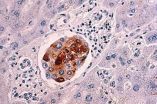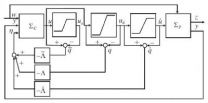(Press-News.org) MADISON – In efforts to understand what influences life span, cancer and aging, scientists are building roadmaps to navigate and learn about cells at the molecular level.
To survey previously uncharted territory, a team of researchers at UW-Madison created an "atlas" that maps more than 1,500 unique landmarks within mitochondria that could provide clues to the metabolic connections between caloric restriction and aging.
The map, as well as the techniques used to create it, could lead to a better understanding of how cell metabolism is re-wired in some cancers, age-related diseases and metabolic conditions such as diabetes.
"It's really a dynamic atlas for regulatory points in mitochondrial function -- there are many interesting avenues that other scientists can follow up on," says John Denu, professor of biomolecular chemistry and leader of the Epigenetics theme at the Wisconsin Institute for Discovery (WID). "It could take years for researchers to understand what it all means, but at least now we have a list of the most important players."
In previous experiments, it's been shown that consuming less food increases the life span and health span in a range of organisms, from yeast and flies to mice and non-human primates. But pinpointing where and how caloric restriction affects cells at a molecular level remains the challenge.
So far, mitochondrial proteins, the molecules that command specific actions in the cell's powerhouse organelle, are at center stage of metabolic reprogramming.
Denu and colleagues conducted earlier research on the mitochondrial protein Sirt3, where they suggested a link between Sirt3 and the benefits of caloric restriction in situations such as the prevention of age-related hearing loss.
The new research, published in the Nov. 29 issue of the journal Molecular Cell, more broadly identifies pathways in mitochondria that could be behind the re-wiring of metabolism. Their work uncovered regulatory processes that maintain mitochondrial health, control cells' ability to metabolize fat and amino acids, as well as stimulate anti-oxidant responses. This re-wiring involves the addition or removal of two-carbon (acetylation) chemical groups within regulatory molecules called proteins.
In the study, scientists looked at liver tissue from groups of mice -- both with and without the ability to produce Sirt3.
Some received a calorically restricted diet and some did not. After one year, they compared protein and acetylation changes among the groups of mice. They found Sirt3 was essential for many of the metabolic adaptations that occur during calorie restriction. These results suggest that therapies, including diet or drugs that enhance Sirt3 function, might provide novel interventions to fend off age-related illnesses.
Joshua Coon, professor of chemistry and biomolecular chemistry at UW-Madison and co-author of the paper, crafted a new technique to find these molecular sites. While the genome plays a key role in an organism's health, he points out that studying proteins -- the molecular machines that carry out an organism's original genetic instructions -- can be more accurate in revealing how a gene functions.
"We've taken dozens of primary tissues and profiled their protein content with depth to learn how they vary," Coon says. "With that information, we have direct knowledge at the molecular level of how an organism is dealing with adaption to diet, or potentially, a given disease state."
He says using mass spectrometry to look for acetylated proteins from tissue samples is a more fruitful approach to identify relevant physiological changes. The study, he says, is one of the first of many that will create descriptive maps for other disease models.
To expand access to these enabling technologies across campus, Coon plans to launch the Wisconsin Center for Collaborative Proteomics in 2013. The center has received significant support from the UW and is pending further support via federal funding.
INFORMATION:
-- Marianne English, 608-316-4687, menglish@discovery.wisc.edu
END
A team of scientists, led by researchers at the University of California, San Diego School of Medicine, has shown for the first time how cancer cells control the ON/OFF switch of a program used by developing embryos to effectively metastasize in vivo, breaking free and spreading to other parts of the body, where they can proliferate and grow into secondary tumors.
The findings are published in the December 11 issue of the journal Cancer Cell.
In 90 percent of cancer deaths, it is the spreading of cancer, known as metastasis, which ultimately kills the patient by impacting ...
A diagnosis of pancreatic cancer is particularly devastating since the prognosis for recovery is usually poor, with the cancer most often not detected until late stages.
Research led by scientists at the University of California, San Diego and UC San Francisco Schools of Medicine examined the tumor-initiating events leading to pancreatic cancer (also called pancreatic ductal adenocarcinoma or PDA) in mice. Their work, published on line November 29 in the journal Cancer Cell, may help in the search for earlier detection methods and treatments.
"Previously, it was believed ...
The scents which permeate our health spas from aromatic essential oils may provide more benefits than just a sense of rest and well-being.
For according to a new study(1) in the European Journal of Preventive Cardiology, the essential oils which form the basis of aromatherapy for stress relief are also reported to have a beneficial effect on heart rate and blood pressure following short-term exposure - and may therefore reduce the risk of cardiovascular disease. However, on the downside, those beneficial effects were reversed when exposure to essential oils lasted more ...
Washington, DC (November 27, 2012) –A new study in the Journal of Communication links verbal aggression to prenatal testosterone exposure. The lead researcher, at University at Buffalo – The State University of New York, used the 2D:4D measure to predict verbal aggression. This study is the first to use this method to examine prenatal testosterone exposure as a determinant of a communication trait.
Allison Z. Shaw, University at Buffalo – The State University of New York, Michael R. Kotowski, University of Tennessee, and Franklin J. Boster and Timothy R. Levine, Michigan ...
Treatment with a novel agent that inhibits the activity of SIRT2, an enzyme that regulates many important cellular functions, reduced neurological damage, slowed the loss of motor function and extended survival in two animal models of Huntington's disease. The study led by Massachusetts General Hospital (MGH) researchers will appear in the Dec. 27 issue of Cell Reports and is receiving advance online release.
"I believe that the drug efficacy demonstrated in two distinct genetic HD mouse models is quite unique and highly encouraging," says Aleksey Kazantsev, PhD, of ...
Researchers have defined the gene responsible for a rare developmental disorder in children. The team showed that rare variation in a gene involved in brain development causes the disorder. This is the first time that this gene, UBE3B, has been linked to a disease.
By using a combination of research in mice and sequencing the DNA of four patients with the disorder, the team showed that disruption of this gene causes symptoms including brain abnormalities and reduced growth, highlighting the power of mouse models for understanding the biology behind rare diseases.
"Ubiquitination, ...
Economists and professionals praise the merits of competition, as it leads to lower prices and improvements in quality. But in the automobile smog-testing industry, competition can lead to corruption and even public health problems, according to research by USC Marshall School of Business Assistant Professor of Management Victor Bennett.
Bennett, along with colleagues Lamar Pierce of Washington University's Olin School of Business, Jason Snyder at the UCLA Anderson School of Management and Michael W. Toffel of Harvard Business School, found that the structure of the smog-testing ...
PASADENA, Calif., Nov. 29, 2012 – Immunizing older adults with the tetanus-diphtheria-acellular-pertussis vaccine (Tdap) to prevent pertussis (more commonly referred to as whooping cough) was found to be as safe as immunizing them with the tetanus and diphtheria (Td) vaccine, according to a study by Kaiser Permanente published in the journal Clinical Infectious Diseases.
Researchers examined the electronic health records of nearly 120,000 people ages 65 and older at seven U.S. health systems between Jan. 1, 2006 and Dec. 31, 2010. The study looked at a number of medical ...
Actuator saturation is ubiquitous in engineering systems. Anti-windup approach to dealing with actuator saturation has been receiving considerable attention from both the industry and the academic community during the past decades. Professor Zongli Lin and his student Xiongjun Wu developed a new anti-windup design paradigm that is capable of achieving significantly improved performances of the resulting closed-loop system. Their work, entitled "Design of multiple anti-windup loops for multiple activations," was published in SCIENCE CHINA Information Sciences, 55(9), 2012. ...
The detection and recognition of an object with small RCS, such as a stealth target, is the most difficult problem to solve for the modern radar system. Professor Hu Cheng and his group at Radar Research Lab, Beijing Institute of Technology set out to tackle this problem. After seven years of innovative research, they have developed a series of methods to detect, track and recognize some targets with small RCS. In particular, they proposed a novel imaging method based on the principle of shadow inverse synthetic aperture radar (SISAR) to extract the target profile accurately ...



